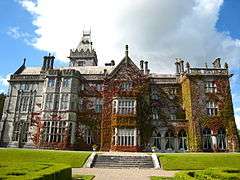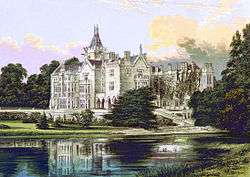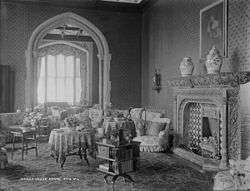Adare Manor
| Adare Manor | |
|---|---|
 | |
 | |
| General information | |
| Architectural style | Tudor revival[1] |
| Town or city | Adare, County Limerick |
| Country | Republic of Ireland |
| Coordinates | 52°33′50″N 8°46′43″W / 52.563886°N 8.778573°W |
| Construction started | c. 1700 (original structure); 1832 (current structure) |
| Completed | 1862 |
| Renovated | 1988/89[1][2] |
| Client | Windham Henry Quin |
| Owner | J.P. McManus |
| Design and construction | |
| Architect |
James Pain and George Richard Pain, Lewis Nockalls Cottingham, Augustus Pugin, Philip Charles Hardwick |
Adare Manor is a manor house located on the banks of the River Maigue in the village of Adare, County Limerick, Ireland, the former seat of the Earl of Dunraven and Mount-Earl. The present house was built in the early 19th-century, though retaining some of the walls of the 17th-century structure. It is now the Adare Manor Hotel & Golf Resort, a luxury resort hotel.
History


The first mention of a manor on the land is following the Norman invasion of Ireland. In 1226, King Henry III gave a grant to Justiciary of Ireland Geoffroi de Morreis (de Marisco) to hold an eight-day annual fair following the Feast of St. James at his Manor of Adare.[3]
The lands subsequently were granted to the Earls of Kildare, members of the Welsh-Norman FitzGerald family who came to Ireland in 1169. In 1536, the act of attainder was passed against Thomas FitzGerald, 10th Earl of Kildare, whose lands, castles and manors were forfeited to the crown.
In a letter dated 24 March 1547, the boy king Edward VI granted the Earls of Desmond "the manors and dominions of Croom and Adare, in the county of Limerick, to hold for life."[4] The grant was short lived; the Desmond Rebellions brought control of the lands to the St. Leger family. For the next century, the lands passed from 10 families: St. Leger, Zouch, Gold, Rigges, Wallop, Norreis (Norris), Jephson, Evans, Ormesby (Ormsby), and then Quin.[5]
Thady Quin, Esq. (1645–1726) of Gortfadda, County Leitrim, purchased the moiety in 1669 and continued to add surrounding land through 1702. He received the last land grant for Adare, on 16 December 1684, to hold the lands for a thousand years, "paying to Gilbert Ormsby and his heirs the rent of £230."[6] The earliest section of the first manor house was presumably a square or oblong tower, likely erected by Thady Quin at the end of the 17th century.[3]
The deed of conveyance, dated 23 February 1721, transferred the following land to Thady's eldest son, Valentine Quin:
The estate of Adare extended northwards nearly to the Shannon, and comprehended a considerable portion of the parishes of Kildimo and Chapelrussell, and the north-western section of Adare situate in the barony of Coshma, with a portion of Drehidtarsna, and parts of Kilkeedy and Croom, lying in the barony of Pubblebrien. The Manor of Tobernea was situate in the south-eastern part of the county, embracing the extreme southern portion of the barony of Coshma, with the adjacent part of Coshlea, and contained a considerable part of the parishes of Effin, Ballingarry, and Kilbreedy Minor— Caroline Wyndham-Quin, Countess of Dunraven, Memorials of Adare Manor, 1865

Valentine Quin was the grandfather of Valentine Richard Quin (1752–1824), the first Earl of Dunraven. Valentine Richard Quin, MP for Kilmallock (1799–1800), was created a Baronet of Great Britain in 1781 and was raised to the peerage in 1800 as Baron Adare. He was advanced to a Viscountcy in 1816 as Viscount Mount Earl and became Viscount Adare and the first Earl of Dunraven and Mount-Earl on 5 February 1822. He chose the title of Dunraven in honour of his daughter-in-law Caroline Wyndham, daughter and heiress of Thomas Wyndham of Dunraven Castle, who in 1810 had married his eldest son and heir, Windham Henry Quin.
Around 1785, the first Earl of Dunraven made significant alterations to Adare Manor, raising more walls and changing the entrance from the south front to the northwest side.[7] In 1786, it was described as "a very noble structure with fine and extensive demesnes."[8]
Valentine Richard Quin's earldom lasted only two years; upon his death to 1824 the title passed to Windham Henry Quin, the second Earl of Dunraven and Mount-Earl. The new Earl, who was suffering from gout and confined indoors, rebuilt his home, turning it from a classic Georgian mansion into a large Tudor Revival manor.[9] Building the new manor involved the rebuilding, enlarging and subsequent demolition of the earlier 18th-century manor house of the Quin family.[1] Begun in 1832, construction provided work for the people from the surrounding villagers during the potato famine.[2]
Some of the old walls of the manor were preserved and encased in the new work, including the north and south walls of the dining room, and the walls between the hall and gallery. When the walls of the old tower were broken to form the door between the hall and gallery, a silver coin "of considerable antiquity" was discovered.[10] The construction was still unfinished by the death of the second earl in 1850, after which the family consulted architect Philip Charles Hardwick, who "with much talent and judgment completed the south and west fronts, after his own designs, following the general plan as intended by the late Earl," his widow wrote.[11]

Although Lady Caroline claimed that Adare Manor was planned entirely by her husband at first,[2] the initial architectural plans for the house were made by James and George Richard Pain. The client dispensed with their services, however, around 1838, and Lord Dunraven continued with the design of the house himself with help from English architect Lewis Nockalls Cottingham. The initial phase of construction was completed under master mason, James Connolly, together with the second Earl of Dunraven and his wife, who incorporated their favourite buildings into the design.[1]
Augustus Pugin was hired in 1846 to design some of the interior features including the great hall. The three-storey southern range and the tower with pyramidal roof, completed by the third Earl of Dunraven between 1850 and 1862, were built to the designs of Philip Charles Hardwick.[1]
An inscription on the east front of Adare Manor commemorates "James Conolly of Adare, mason, faithful friend and servant of the Earl of Dunraven, from AD 1831 till his death in 1852."[12]
The new manor was built of large blocks of grey, red and brown limestone. On the parapet of the south front, a verse from Psalms 127:1 is etched in old English characters: "Except the Lord build the house: their labour is but lost that build it." Further verses "Love God onely," "Honour and obey the Queen," and "Eschew evil and do good" are carved onto the colonnade.[11]
At the time of Griffith's Valuation in 1868, the property was valued at only £130 (equivalent to £10,549 in 2015); in 1906 the buildings at Adare Manor were valued at just £182 (equivalent to £17,655 in 2015).[8]
Subsequent sales
Thady Wyndham-Quin, 7th Earl of Dunraven and Mount-Earl (1939–2011), who was crippled by polio while a schoolboy, lived with his family in a nearby house called Kilgobbin House. Unable to bear the expense of maintaining Adare Manor, he sold it and its contents in 1982 to an investment consortium. In 1987, the house was purchased by Irish American Thomas Kane from Florida.[13] It was then renovated and converted to become the Adare Manor Hotel and Golf Resort.[2]
On the 30 January 2015, Adare Manor was bought by Limerick business man J.P. McManus for an estimated €30 million. McManus hosted pro-am golfing events at Adare in 2005 and 2010.[14] On 28 and 29 January 2016 many of the hotel contents were sold at a public auction.[15]
Design
The building is a calendar house, featuring 365 windows and 52 chimneys, among some other design characteristics. Along the top of the building an extract of psalm 127:1 is made from carved stone: "Except the Lord build the house, then labour is but lost that built it".
Adare Manor Hotel & Golf Resort
The house is set on a 840-acre (3.4 km2) estate and now operates as a five-star hotel, featuring the Adare Golf Club, Lavender Cottage, Townhouses and Villas on the rest of the resort. Adare Manor was voted "Ireland's Leading Hotel" at the World Travel Awards in 2010, 2011 and 2012 and "The World's Leading Boutique Golf Resort" in 2012.[16] As of spring 2016 the main hotel remains closed for refurbishment, but the villas are still in operation.[17]
Golf
The Adare Golf Club, an 18-hole championship course designed by Robert Trent Jones, Sr., was added to the resort in 1995, and was the venue for the Irish Open in 2007 and 2008. It also played host to the J.P. McManus Invitational Pro Am in 2005 and 2010.[18] McManus has confirmed that the invitational Pro Am will return to Adare Manor in either 2016 or 2017.[19]
The Adare Manor Golf Club, which was established in 1900, is not part of the Adare Manor Resort.
Cricket
A cricket ground has been added to the manor and became the home ground of Limerick Cricket Club, a club in the Munster Cricket Union in 2011, therefore ending the nomadic nature of the club. The club has been remarkably successful in its debut year playing in the ground.
In popular culture
Adare Manor and its grounds were used for the 1977 comedy film The Last Remake of Beau Geste, starring Marty Feldman, Ann-Margret and Michael York.[20]
In 2010, Adare Manor served as the judge's house for Sharon Osbourne and Louis Walsh on The X Factor.[21]
References
- 1 2 3 4 5 "National Inventory of Architectural Heritage: Adare Manor". Department of Arts, Heritage and the Gaeltacht. Retrieved 24 February 2015.
- 1 2 3 4 "Fact Sheet". Adare Manor Hotel & Golf Resort.
- 1 2 Wyndham-Quin, p. 137.
- ↑ Wyndham-Quin, pp. 245-246.
- ↑ Wyndham-Quin, p. 145.
- ↑ Wyndham-Quin, p. 38.
- ↑ Wyndham-Quin, p. 121.
- 1 2 "Landed estates database: Estate — Adare Manor". NUI Galway. Retrieved 24 February 2015.
- ↑ "Adare Manor History". Adare Manor Hotel & Golf Resort. Retrieved 14 March 2015.
- ↑ Wyndham-Quin, p. 147.
- 1 2 Wyndham-Quin, p. 7.
- ↑ "Conolly, James". Dictionary of Irish Architects.
- ↑ Alan Cowell (20 June 1999). "The Cash Of the Irish Is Talking In Castles". The New York Times. Retrieved 14 March 2015.
- ↑ Pamela Newenham (4 February 2015). "Adare Manor sold to businessman JP McManus.". Irish Times. Retrieved 14 March 2015.
- ↑ http://www.irishexaminer.com/ireland/pics-relics-of-ascendency-under-the-hammer-at-adare-manor-auction-378795.html
- ↑ "Adare Manor Hotel & Golf Resort". World Travel Awards. Retrieved 14 March 2015.
- ↑ "Temporary closure for refurbishment". Adare Manor Hotel. Retrieved 12 April 2016.
- ↑ "Golf Society brochure" (PDF). Adare Manor Hotel. Retrieved 14 March 2015.
- ↑ "JP McManus confirms return of golf Pro-Am to Adare Manor". limerickleader.ie.
- ↑ Ireland Today, Issues 879-941. Ireland Today. 1976. p. 70.
- ↑ "Beautiful Adare Manor shows it has the X Factor". Limerick Leader. 28 August 2010. Retrieved 17 May 2015.
Further reading
- Caroline Wyndham-Quin, Countess of Dunraven (1865). Memorials of Adare Manor. Oxford. ISBN 978-1-235-91578-9. (available at the Internet Archive)
External links
- Adare Manor Hotel - official site
- Adare Golf Club - official site
Coordinates: 52°33′50″N 8°46′43″W / 52.563886°N 8.778573°W
